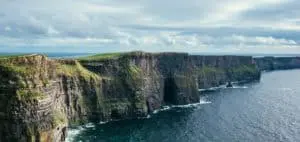Exploring the Rich History of Gold in Ireland: From Ancient Treasures to Modern Discoveries

Updated On: April 23, 2024 by Raghda Elsabbagh
Ireland, a land celebrated for its lush greenery and cultural heritage, harbours a lesser-known narrative beneath its surface — that of gold exploration and potential. This friendly blog post offers a lantern through time, delving into Ireland’s bountiful golden lineage and emphasising how our progenitors’ skill with this precious metal has moulded our modern existence. Are you ready to unearth some golden nuggets in this Irish narrative? Let’s dive right in as we pull back the shimmering curtain on the gold in Ireland!

Table of Contents
Ancient Treasures of Irish Gold
Ancient treasures of Irish gold, such as lunulas and Bronze Age gold artefacts, offer a remarkable glimpse into the significance and use of gold in prehistoric Ireland.
Lunulas and Bronze Age Gold
During the Bronze Age, skilled workers crafted lunulas, thin crescent-shaped neck pieces, from gold. The best ones came from Croagh, in Wicklow. These works of art are now kept at the National Museum in Dublin. Gold was very dear to these old peoples’ hearts. It had a deep meaning for them, and it spoke of their bond to otherworldly beings after death.
Significance and Use of Gold in Prehistoric Ireland
Gold held immense significance in prehistoric Ireland. It was not just a precious metal but also symbolised power, wealth, and spirituality for the ancient Celts. The craftsmanship of gold artisans during this time was exceptional, evident in the intricate designs found on artefacts like lunulas and Celtic gold jewellery.
Gold was considered a link to the divine world and played a crucial role in burial rituals and religious ceremonies. The discovery of golden treasures in burial sites highlights the importance of gold in ancient Irish culture. These findings provide valuable insights into the social structure, beliefs, and customs of prehistoric Ireland.
The Avoca Mines: An Episodic Gold Rush

However, it wasn’t until the 18th and 19th centuries that notable gold rushes occurred, most notably in County Wicklow and County Tyrone. Among Ireland’s notable gold rushes, the Avoca mines in the Wicklow Mountains stand out as a testament to early exploration fervour. The 1790s witnessed a surge of activity as miners flocked to the region, extracting considerable amounts of gold. Despite initial success, technical challenges and diminishing yields led to the eventual closure of the mines, marking a temporary halt to large-scale gold extraction in the area.
Geological Awakening: Revival of Interest
Throughout the 20th century, sporadic gold discoveries and geological surveys hinted at the untapped potential lying dormant beneath Ireland’s soil. It wasn’t until recent decades that renewed interest in gold exploration emerged, driven by advancements in geological understanding and exploration technologies.
Regional Variations in Gold Mineralisation

In exploring the presence of gold in Ireland, it’s crucial to recognise the regional variations in gold mineralisation. Geological factors play a significant role in determining the distribution and abundance of gold deposits across different areas of the country.
Tyrone-Caledon Terrane: One of the most promising regions for gold exploration in Ireland is the Tyrone-Caledon Terrane, located primarily in Northern Ireland. This geological unit has a complex tectonic history, including the collision of ancient continents and subsequent deformation events. These geological processes have created favourable conditions for the formation of gold-bearing deposits, with high-grade mineralisation occurring in areas such as the Dalradian Supergroup.
County Wicklow: Historically known for its gold rushes, County Wicklow in the east of Ireland has long been associated with gold mineralisation. The region’s geology, characterised by metamorphic rocks and fault zones, has provided the structural framework for gold deposition. While early mining activities in County Wicklow yielded significant amounts of gold, modern exploration efforts continue to uncover new prospects in this area.
Other Prospective Regions: Beyond Tyrone-Caledon and County Wicklow, several other regions in Ireland show potential for gold mineralisation. These include areas with similar geological characteristics, such as metamorphic rocks, fault systems, and volcanic formations. Ongoing geological surveys and exploration activities aim to identify additional gold-bearing zones across the country.
Understanding the geological context of each region is essential for targeting exploration efforts and assessing the potential for economic gold deposits. Geological mapping, geophysical surveys, and drill testing play key roles in delineating prospective areas and evaluating their mineralisation potential.
Modern Discoveries of Irish Gold
Currently, gold mining is actively taking place in Ireland, and significant gold deposits have been discovered throughout the country.

Current Gold Mining in Ireland: Unlocking Ireland’s Gold Potential
Gold mining in Ireland continues today, adding to its rich history. In recent years, significant gold deposits have been discovered in various locations across Ireland.
Some notable areas for current gold mining include Waterford, Dungarvan, Stradbally, and the Gold Coast. Companies like Conroy Gold and Omagh are actively extracting gold from these sites.
Contemporary exploration efforts also focus on regions such as the Tyrone-Caledon terrane, where complex geological structures offer promising prospects for gold mineralisation. Companies like Dalradian Resources have spearheaded exploration endeavours, uncovering high-grade gold deposits that have piqued the interest of investors and industry stakeholders alike.
This creates opportunities for travellers to explore and learn about the modern gold mining industry in Ireland.
Recent Discoveries of Significant Gold Deposits
In recent years, exciting discoveries of significant gold deposits in Ireland have been made. These findings have not only added to the country’s rich history of gold but also sparked interest among travellers and history buffs.
One such discovery occurred in County Monaghan by Conroy Gold and Natural Resources. They found a sizable gold deposit near Clontibret that has the potential for large-scale extraction.
Another notable find was made in Omagh by Galantas Gold Corporation, who identified an underground vein containing high-grade gold ore. These recent discoveries highlight the ongoing exploration and potential growth of Ireland’s modern gold mining industry, continuing the legacy of Irish gold treasures throughout time.
Economic Implications of Gold Mining in Ireland
The presence of gold deposits in Ireland carries significant economic implications. They have the potential to stimulate economic growth, create employment opportunities, and generate revenue for local communities and the national economy.
Job Creation: Gold mining operations, from exploration to production, require a diverse range of skilled workers, including geologists, engineers, miners, and support staff. The development of gold mines in Ireland has the potential to create jobs across various sectors, providing employment opportunities in rural and regional areas where mining activities are concentrated.
Revenue Generation: Gold mining contributes to revenue generation through various channels, including taxes, royalties, and corporate profits. Government revenue derived from gold mining can support public services, infrastructure development, and social welfare programs. Additionally, royalties and lease payments provide direct financial benefits to landowners and local communities hosting mining operations.
Economic Diversification: Establishing a viable gold mining industry in Ireland can contribute to economic diversification and reduce dependence on traditional sectors such as agriculture and tourism. By attracting investment and fostering innovation, gold mining can stimulate ancillary industries and supply chains, creating a multiplier effect that boosts economic activity in related sectors.
Tourism and Heritage: Gold mining activities, past and present, have the potential to attract tourists and promote cultural heritage tourism in Ireland. Historic gold mining sites, museums, and interpretive centres offer opportunities for visitor engagement and education, contributing to the tourism sector’s growth and enhancing the cultural identity of local communities.
Overall, the economic implications of mining gold in Ireland extend beyond the mining sector itself, with potential benefits for broader economic development and regional prosperity. However, it’s essential to balance economic opportunities with environmental conservation and social considerations to ensure sustainable and responsible mining practices.
Navigating Challenges: Environmental Concerns and Regulatory Hurdles
Despite the allure of gold exploration, challenges abound. Ireland’s stringent environmental regulations and the imperative for social acceptance pose significant obstacles for mining companies. Balancing economic interests with environmental stewardship and community engagement remains a paramount concern in any mining endeavour.
Towards a Sustainable Future: Responsible Mining Practices
The future of gold exploration in Ireland hinges on the adoption of responsible mining practices and sustainable development principles. As exploration continues and new discoveries are made, mining activities must be conducted with utmost regard for environmental preservation and societal well-being.
A Glimmer of Promise

In conclusion, Ireland’s rich history of gold spans from ancient times to the present. From the discovery of Bronze Age gold artefacts to modern-day mining operations, the allure of Irish gold continues. With ongoing discoveries and a legacy steeped in mythology and hidden treasures, exploring Ireland’s gold history is an exciting journey into the past and present.
FAQs
What does it mean when we talk about exploring the rich history of gold in Ireland?
Exploring the rich history of gold in Ireland means learning about Irish gold jewellery, ancient gold mines, and natural occurrences of the precious metals found by archaeologists.
Was there historical gold mining in Ireland?
Yes, there was historical gold mining in Ireland. Gold extraction techniques from old times left behind many ancient artefacts.
Can you find bits of real gold today while visiting areas known for ancient mines?
Yes! You can try your hand at gold panning in regions noted for ancient and historical mines across beautiful Irish landscapes blessed with juicy deposits.
How big a role did trade play back when Celtic folks made bling out of this shiny stuff?
Trade had a large part to play! Gold trade routes were crucial for ancients as they sculpted Celtic jewellery pieces that still inspire awe today.
Are stories spun around finding or using this gleaming bit?
Yes indeed! Many myths and legends surround gold use within the Emerald Isle’s age-old practices.






